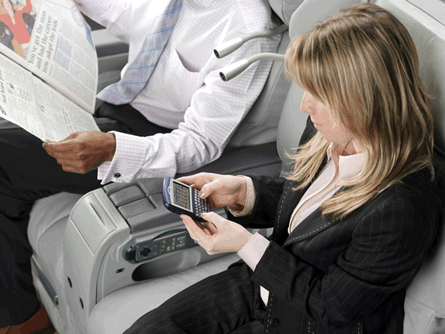In-flight connectivity enjoyed a second coming in 2009. After a false start by Connexion by Boeing earlier in the decade, service providers gained traction in the market last year as airlines from across the globe retrofitted their aircraft with various airborne communications systems.
The excitement over connectivity was most palpable in the USA, where Aircell operates a dedicated network of cell towers and holds an exclusive broadband spectrum licence to offer air-to-ground service, which is billed as a less costly alternative to satellite-based solutions.
These factors, combined with what industry insiders believe to be Aircell's willingness to finance installations, made the Chicago-headquartered firm the dominant in-flight connectivity player on the US domestic scene.
By the end of 2009, 695 aircraft in the US fleet had been retrofitted with Aircell's Gogo service, which allows passengers to use their own wi-fi-enabled devices for internet access.
 |
|---|
© AeroMobileAsian, European and Middle Eastern operators are offering mobile telephone connectivity |
An announcement in December that Continental Airlines is equipping 21 Boeing 757-300s with Gogo means that all US legacy carriers have now made some level of commitment to deploy Gogo.
Among the US carriers that did not jump on the Gogo bandwagon in 2009 were Alaska Airlines and Southwest Airlines. Instead they turned to California-headquartered newcomer Row 44 for a Ku-band satellite-based broadband internet solution that aims to fill the void left by Connexion's 2006 demise, and, unlike Gogo, can support connectivity on overseas flights.
Across the Atlantic, former Connexion operator - and launch customer - Lufthansa signed a deal with Panasonic Avionics to reinstate Ku-band airborne internet service on its long-haul fleet, in a move that could set the benchmark for connectivity on overseas flights.
MOBILE CONNECTIONS
Meanwhile, operators in Asia, Europe and the Middle East in 2009 retrofitted their aircraft with Inmarsat L-band satellite-supported mobile telephone connectivity solutions on offer from Arinc/Telenor partnership AeroMobile and Airbus/Sita joint venture OnAir.
With orders for in-flight connectivity systems continuing to stack up, there is little doubt that rapid deployment of connectivity systems will continue into 2010 and beyond.
More than 2,500 aircraft in the global commercial fleet are expected to be installed with passenger connectivity systems by the end of 2010 and that number will grow to 4,500 in 2013, according to in-flight entertainment and communications consultancy IMDC.
Some aircraft will be delivered line-fitted with connectivity systems. Airbus has already made clear that it sees Inmarsat's higher-bandwidth SwiftBroadband aeronautical service as the entry point to connectivity.
"Airlines are going to pay because it's going to become the cost of doing business"Michael PlaneyConsultant |
The airframer recently delivered to Oman Air an A330-300 line-fit with the Airbus ALNA v2 platform over SwiftBroadband, which enables OnAir's Internet OnAir and Mobile OnAir solutions. All future Oman A330s will be delivered with connectivity.
Boeing has made a soft indication that it might follow Airbus's lead, recently issuing a request for information for a SwiftBroadband-supported satcom interface and on-board mobile telephony installation for the 787 twinjet.
But while in-flight connectivity is poised to become commonplace on board aircraft, it may never generate the type of financial windfall that was part of service providers' original sales pitch to airlines by service providers.
Tired of being "nickled and dimed" for everything from baggage fees to on-board beverages, US travellers are starting to reach a point of "fee-fatigue" and are less inclined to pay for optional services, such as in-flight wi-fi, says IFEC consultant Michael Planey.
He predicts that connectivity on short- and medium-haul flights in the USA "is going to be free in less than two years".
If that occurs, and to keep the service alive, "airlines are going to pay because it's going to become the cost of doing business".
Source: Flight International








































